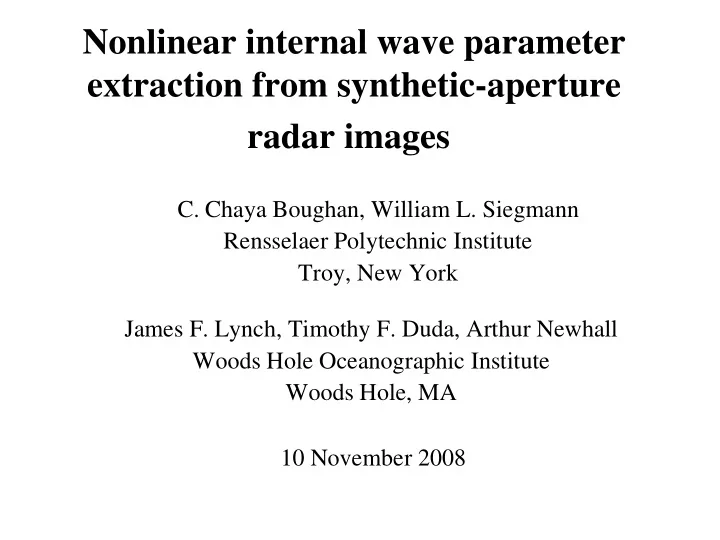

Nonlinear internal wave parameter extraction from synthetic-aperture radar images C. Chaya Boughan, William L. Siegmann Rensselaer Polytechnic Institute Troy, New York James F. Lynch, Timothy F. Duda, Arthur Newhall Woods Hole Oceanographic Institute Woods Hole, MA 10 November 2008
Motivation • Do SAR images of Nonlinear Internal Waves (NIWs) reliably represent ground truth? • Use of many SAR images, fewer moorings to extract NIW parameter estimates? • Sufficient information available for useful estimates? • Compare parameter estimates from SAR images and SW06 moorings?
Objectives • Extract signals from SAR images, underwater moorings • SAR – Approach 1: Generate intensity level curves • Extract NIW parameters – Approach 2: Use fingerprint analysis / edge segmentation • Compare estimates • Moorings: Process time series – Extract NIW parameters – Compare image, mooring parameters • Time Series ➙ observe NIW progression – Generate isotherms along mooring over time
Parameter Extraction from SAR Images • Approach 1 – Create intensity image – Introduce window- averaged baseline – Estimate: • Base-to-peak height (A i ) • Inter-peak distance (D i ) • Width (W i )
Parameter Statistics • Select Region of Interest • Create sequence of 19 intensity profiles • Obtain parameter statistics Approach 1 A D (km) W (km) µ 0.31 0.45 0.38 σ 0.17 0.20 0.05 med 0.32 0.40 0.39
Approach 2: Edge Extraction 1. Normalized Intensity 2. Edge Identification 3. Masked Image 4. Extracted Edges
Parameter Extraction from Edge Image • Identify and label connected components • Calculate statistics • Example: width W (km) App 2 App 1 µ 0.34 0.38 σ 0.08 0.05 med 0.36 0.39
Approach 2: Other Possible Parameters • Longwave correlation length • Crosswave correlation length
Parameter Extraction from Mooring Data • Moorings chosen by – Placement – Number of sensors • Estimate NIW packet speed – WHOI: v ≈ 0.8 m/s • Time series chosen to reflect – 2 SAR images separated by passage of NIW packets 0.5 hr: v ≈ 0.6 m/s – Time series normalization: – Time series from 4 moorings: max amp ≈ 13 ° allows v ≈ 0.78 m/s comparison w/ linescan data
Mooring Data Analysis Temperature signal ➙ remove small fluctuations ➙ insert baseline ➙ replace extrema
Parameter Statistics • Mooring 54 at array center, 47 is westernmost • Timeseries spans 3-4 hrs at each mooring Mooring Statistics A D (km) W (km) W (km) A D (km) µ 0.34 0.45 0.42 0.34 0.45 0.42 σ 0.09 0.11 0.19 0.09 0.11 0.19 med 0.35 0.44 0.37 0.35 0.44 0.37
Parameter Comparison A Mooring App 1 D (km) Mooring App 1 µ µ 0.34 0.31 0.45 0.45 0.34 0.45 σ σ 0.09 0.17 0.11 0.20 0.09 0.11 med 0.35 0.32 med 0.44 0.40 0.35 0.44 W (km) Mooring App 1 App 2 µ 0.42 0.38 0.34 0.42 σ 0.19 0.05 0.08 0.19 med 0.37 0.39 0.36 0.37
Interpolated Temperature Contours • Data from 4 moorings interpolated into horizontal distance versus time
Interpolated Temperature Contours • NIW packet can be seen passing through region • As wave moves shoreward: – Amplitude increases – Wave speed decreases
Summary and Future Work • SAR image and mooring data show correlated NIW behavior in shallow water • Algorithms can be devised to extract estimates of NIW parameters efficiently and semi-automatically • Comparison of estimates from SAR images, mooring data: – Good agreement in wave amplitudes – Good agreement in peak widths and separations • Continue edge parameter extraction – Wave separation, crosswave and longwave correlation • Modify current algorithm for enhanced edge extraction • Assimilate SAR information into mooring data interpolation
Thanks to Office of Naval Research -- whose support made this work possible.
Recommend
More recommend